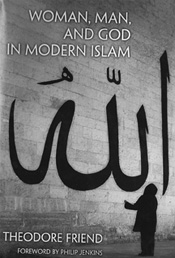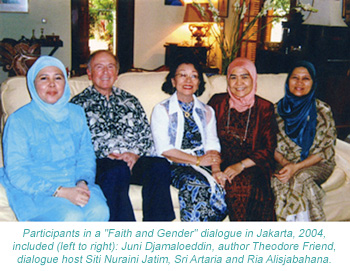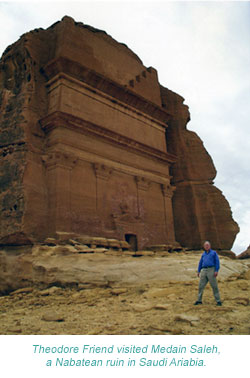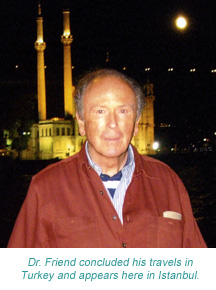![]()
Sisterly Muslims and Brotherly Love
A review of Woman, Man, and God in Modern Islam,
by Theodore Friend
(Eerdmans, Grand Rapids, 2012, 378 pages)
Reviewed by David Denny
 For thirty years I lived at the Spiritual Life Institute, a monastic community that offers hospitality and solitude to retreatants who wish to go into the desert to pray. One of our most fascinating guests was Theodore Friend, a Southeast Asia historian, former president of Swarthmore College, President Emeritus of Eisenhower Fellowships, and a Senior Fellow at the Foreign Policy Research Institute. His conversation is always stimulating because he combines a genuine eagerness to hear what his partner has to say and a critical probing that drives me to examine, re-examine, and question the reasons for - and the reasonableness of - my convictions. He carries this intelligent curiosity through his new book recounting recent travels and encounters in Indonesia, Pakistan, Saudi Arabia, Iran and Turkey.
For thirty years I lived at the Spiritual Life Institute, a monastic community that offers hospitality and solitude to retreatants who wish to go into the desert to pray. One of our most fascinating guests was Theodore Friend, a Southeast Asia historian, former president of Swarthmore College, President Emeritus of Eisenhower Fellowships, and a Senior Fellow at the Foreign Policy Research Institute. His conversation is always stimulating because he combines a genuine eagerness to hear what his partner has to say and a critical probing that drives me to examine, re-examine, and question the reasons for - and the reasonableness of - my convictions. He carries this intelligent curiosity through his new book recounting recent travels and encounters in Indonesia, Pakistan, Saudi Arabia, Iran and Turkey.
Friend travels not as a tourist, but as a pilgrim, friend, and believer deeply concerned with women's well-being, especially in the five countries he visits. He also travels as an historian whose international contacts allow him to meet with government officials, intellectuals, business leaders, activists, artists and theologians. His ability to place the present plight of women in historical, cultural, and religious context allows him to paint subtle portraits that may shatter some readers' prejudices and stereotypical distortions about Muslim cultures and Muslim women. And, alas, he may confirm some of our greatest concerns about the abuse of women. But his subtle eye is quick to tease out varied sources of abusive behavior rather than automatically condemning "Islam" or "Muhammad."
Friend claims that 1979 was a pivotal year for Islam worldwide. It was the year of the Iranian Revolution, Sunni zealots seized the Grand Mosque in Mecca, Zia al-Haq proclaimed the ghastly Hudood Ordinances in Pakistan, and the Soviet Union invaded Afghanistan. Here in the U.S., Jerry Falwell's Moral Majority rose to prominence, reflecting a rising tide of fundamentalism in the Muslim world.

Indonesia
For me, the most hopeful and surprising revelations come in his first chapter, on Indonesia, the world's most populous Muslim country. I know much less about Indonesia than about the other four countries, and Friend has long experience in the region. "Islam is all about revelation, about enlightenment, about liberation, about empowerment," according to Indonesia's President Susilo Bambang Yudhoyono. Muslim women throughout the world take this description to heart. Rather than rejecting Islam as inherently and irredeemably misogynist, strong Muslim women's movements seek greater congruence between the Prophet's vision and Muslim practice.
Indonesia's predominantly Sufi Islam and its pre-Muslim custom of tracing families through both paternal and maternal lines foster a culture averse to demonizing the "other:" female, Christian, Buddhist, or Hindu. In fact, the 1949 Indonesian constitution deliberately rejected embracing shari'a law out of deference to these other deeply rooted and respected Indonesian communities. At present, and since the eighties, Indonesian Islam has drifted toward a less indigenous conservatism, thanks to the worldwide exportation of Wahhabi fundamentalism from Saudi Arabia.
Friend describes the life and work of Wardah Hafidz who, in the present climate, focuses her energies less on combating misogyny and more on poverty and on tsunami recovery in Banda Aceh, where roughly ninety percent of the population died in December 2004. He places the indefatigable Hafidz in the historical context of Malahayati, an Indonesian admiral who commanded the Malacca Strait in the sixteenth century with a force of two thousand women sailors. Hafidz has helped construct over three thousand new homes.
Meutia Hatla is Indonesia's Minister of Women's Empowerment. What kind of country creates such an office? Hatla criticizes male exegetes who miss essential elements in scripture, such as the presence of Mary, who gets more ink in the Qur'an than in the Christian Testament. She insists that the Prophet married for protection of widows, not for desire. She takes a strong stand for Indonesia's history and culture and insists that Arab male standards make no sense there. She suggests that Arab male insistence on covering women may be a projection of their lustfulness, exacerbated by their carnivorous diet. "Too bad there are no vegetables in the sand," she laments. Friend's more agnostic poet friend Siti Nuraini Jatim takes this playful critique further, with an angry edge, suggesting that "if men are promised 72 houris in paradise, then women deserve 72 torreros!"
Friend gives the final word to Siti Musdah Muliah, the first woman to receive a Ph.D. in Islamic political thinking. She is grounded in the work of Arab philosopher Al-Ghazali and she claims the 'relativity of muslim law' and insists that "The whole marital law is man-made; none of it is a fax from heaven. Why be afraid? God won't get mad. He's very wise."
Pakistan
If Indonesia's Islam wears a welcoming smile, Pakistan's Islam, since the eighties, is wary of enemies and, in some cases, defiantly proud of the "Muslim bomb" produced by physicist A.Q. Khan and detonated in 1998. The nuclear program is a stand against India and a fulfillment of Zulfikar Ali Bhutto's assertion that Pakistanis would eat grass, but they would have their bomb. After all, he said, we have Christian, Jewish, Hindu and communist bombs.
Friend's statistics about Pakistani poverty paint a dire portrait. Sixty-six percent of the population lives on less than two dollars a day. Literacy is less than fifty percent, and much lower for women. Desperate families send their boys to one of approximately thirteen thousand madrasas, private Islamic schools that attempt to make up for the lack of public schools. They also promote anti-Western, puritanical (but not usually violent) Islam.
Women such as Shahnaz Wazir Ali promote schools for girls and women's rights to own land, have access to credit, and earn the financial means to help their children.
As for violence against women, Friend notes that it is not simply attitudinal or subtle. Expressions include "wife-beating, bride-burning, acid-throwing, rape, and murder." In four months in 2003, 211 women were reported killed by kin. Most victims are sixteen-twenty five years old, married, and poor. Dowry disputes, husbands' cruelty, suspicion of infidelity, forced sex, and tribal friction are main contributors. Probably only ten percent of survivors testify in court.
I will not summarize the story of rape victim Mukhtaran Bibi here. It is important to know her name, to take the time to learn her story, and to stand in awe of her courage in fighting for the rights of her neighbors and her commitment to educating children.
 Saudi Arabia
Saudi Arabia
The first word that comes to mind as I recall Friend's descriptions of Saudi Arabia is "surreal." The contrast with the grinding poverty of Pakistan boggles the mind. Saudi wealth built the world's second-tallest building, the Royal Mecca Clock Tower that looms over the Kaaba, and Saudi-Wahhabi Islamic authorities ban women from driving. Friend points out that, different as they are, both Saudi Arabia and Iran are skeptical of "civil society," and claim to represent model Islamic states. Their leaders believe that a proper society is governed from above, by God and God's human representatives. Friend gives some history of the Wahhabi movement that struck an alliance with the house of Saud in the eighteenth century. He also narrates a concise history of twentieth century imperialism, the fall of the Ottoman Empire, and the arrival, in 1933, of Aramco. Friend writes that the British lost the initial bid to drill for oil in Arabia because they also wished to influence Arabian culture. America just wanted oil.
Three quarters of the Saudi cabinet were educated in the United States, and many educated technocrats have smart plans for the future. But Friend wonders if the culture and religion will cooperate. Saudi women are more educated than the men and ninety percent believe they have the right to choose their husbands. But the religion-state emphasizes obedience, old men's right to marry child brides; no Muslim woman may marry a Christian, nor can she ever be alone with a man who is not a relative.
But Friend was the first male ever to tour the women's college in Jeddah. Founded in 1999, the curriculum includes business, management and soon, engineering. The students wear abayas, with hoods or scarves. Friend notes that no foreigner may dress as a Saudi. Americans, for example, may earn huge salaries, but they are not allowed to assimilate.
Friend interviewed Madeha al-Ajroush , a psychotherapist and photographer who took part in the "drivers" protest in 1990. Forty-seven women drove cars, were jailed briefly, and persecuted thereafter. The United States was not eager for this story to be broadcast because it reflects badly on our ally. Madeha suggests that women are treated as sex objects in both Saudi and American cultures. They are publicly promoted as such in the U.S., whereas they are closeted in Saudi Arabia. But many of the "drivers" have founded NGOs, become university professors, and founded charities such as Mothers of Riyadh, which offers aid for the poor, and Family Safety, an organization against domestic violence.
The most surrealistic image in Friend's account takes place after his visit with Prince Nayef bin Sultan bin Fawwaz Al-Sha'lan. Prince Nayef earned degrees in international relations at Princeton and engineering in Miami. He discussed Christianity with Friend, noting its scriptural contradictions, impervious to Friend's elegant exegesis, and leaving Friend with the impression that the Prince values clarity over mystery, with the Qur'an offering perfect clarity.
Upon returning to the U.S., Friend conducted more research on his royal host and discovered that in 2007 a French court found Prince Nayef guilty of smuggling cocaine on his Boeing 727. He continues, Friend notes, to study the Abrahamic religions.
Iran
Thirty years after Iran's revolution, the 2009 elections provided an opportunity to challenge the "sacred system" instituted by Ayatollah Khomeini. Democratic forces questioned the establishment; the wife of the main opposition candidate, Mir-Hossein Moussavi, campaigned with her husband and promised that women would take cabinet posts in her husband's government. But after their loss, an estimated eighteen thousand protestors were arrested. Friend's 2005 visit to Iran helped him to understand the turmoil of 2009. He gives a clear account of the history that has led to some Iranians' resistance to democracy. Great Britain and the United States overthrew Prime Minister Mohammad Mossadegh in 1953 in part because he did not see the justice of British Petroleum's taking seven eighths of Iran's oil revenue. This, coupled with the later temporary U.S. asylum for the deposed and ailing Shah and U.S. support for Saddam Hussein's use of chemical weapons against Iran, provoked anti-American passions.
Before embarking on a dangerous pilgrimage, Friend met publisher Makan Zahrai, a publisher who noted that more books are published in Iran than in the entire Arab world. The theme of an ancient non-Arab culture and a reading public recurs in Iranians' attempts to explain how they are different from their Sunni Arab neighbors. Seventy percent of the population is under thirty and sixty-three percent of college students are women. But in spring of 2000, eighteen reformist journals were closed in one day. Daryush Shayegan, professor of comparative philosophy and theology, complains that the Revolution expelled anyone with governing experience and elevated priests who claim to know a lot about life in the seventh century and about heaven, but they make the worst possible governors.
In such an environment, women do not do well. No female candidates were approved in 2005 elections. Iran has a movie industry, although many theaters were burned during the Revolution. Actress Tamineh "Bati" Milani has produced nine feature-length films dealing with middle class Iranian women. In response to her 2001 film "Hidden Half," she earned four death penalties. She was spared only because she was a friend of then-president Khatemi who, after a perplexing search, finally found her in the terrifying Evin Prison, from which he freed her.
Iran is also the home of the world's first Muslim woman recipient of the Nobel Peace Prize: Shirin Ebadi. A judge before the Revolution, she was demoted and later left Iran. She continues to fight for human rights in Iran.
Friend's account of Iran includes some of his most personal reflections. His wife had recently died and his daughter was about to undergo a liver transplant. Against the advice of his friends, he determined to visit Mashhad, the only shrine of a Shi'ite imam in Iran, a place few non-Shi'ites ever see. He wanted to make a pilgrimage and pray for his family.
Mashhad is five hundred miles east of Tehran, along the Silk Road. Its shrine is larger than Vatican City. The gracious scholar Farhad Rahimi agrees to accompany Friend on his pilgrimage and Friend clings to Rahimi's shirt tail as they make their way through a teeming crowd of weeping pilgrims determined to toss offerings of money, mementos and flowers through the shrine's golden lattice. Once out of the crowd, Friend weeps with Rahimi for his mother, his wife Elizabeth, and his daughter as his fears, longings and deepest concerns overwhelm him. Rahimi proclaims this a miracle.
Friend's daughter Timmie recovered from her transplant and two years later bore a child.
Friend's final reflections on Iran concern the uniqueness of Shi'ite messianism, with its hope for the coming of the Mahdi, who will usher in the End Time. Shi'ism was born out of the martyrdom of the Prophet's grandson and this combination of exalted martyrdom and apocalypticism make Iran the most volatile of the five countries Friend visited.
 Turkey
Turkey
Friend concludes his journey in Turkey, the westernmost of his destinations. Touching Europe in its fabled Istanbul, once known as Constantinople, Turkey has moved from being the seat of the Ottoman Empire and the caliphate to being the most secular of the five countries Friend visits. Friend briefly examines the life of Mustapha Kemal, "Ataturk," father of modern Turkey. As the Ottoman Empire fell and the Allies sliced up its territory after World War I, war hero Ataturk rose to power and swiftly transformed his nation. He abolished the sultanate and caliphate, promoted western music and dance, closed Sufi lodges and shrines, introduced the "Christian" calendar and drew on European precedents for new civil, penal and business codes; he instituted the Roman alphabet, discouraged Persian and Arabic names, and promoted mass education. A charismatic leader with a military background, the Turkish military became his staunch enforcer of secularization. This energetic revolution from the top enabled women to vote in local elections in 1930, and by 1935 eighteen women were members of parliament. Ataturk banned religious clothing outside mosques and formal religious ceremonies. In his fifteen years in power, literacy doubled, as did per capita income.
This prodigious secular thrust continued into the later twentieth century, and Friend offers us a fascinating look at Turkish development through his long friendship with former prime minister and President Süleyman Demirel. Having visited the U.S. in the fifties, Demirel was amazed at what Americans had accomplished and went home to pour his energies into building dams, highways, schools, and encouraging mass communication technology.
But with the international rise of Muslim anti-western movements, Islamists emerged as a political force in Turkey. They won elections in 1995 but the military forced them from power in 1997. In 2002 the current president, Islamist Erdogan won office and Turkey is working out a new dynamic in the balance of power. It includes not only the "Kemalist" secularists and the Islamists, but new political parties, vocal social critics, and a more independent judiciary.
Where do women fit in this new dynamic? Even before Ataturk's reforms, Muslim scholar Fatma Aliya challenged a powerful sheikh's contention that the Qur'an and the Prophet commanded all men to take four wives. In the early twentieth century painter and opera star Semiha Berksoy became an international celebrity. Nevertheless, today women's illiteracy is four times higher than men's.
Friend interviews Turkish women who choose to cover their hair and others who do not. Fatma Benli earned a law degree in 1995 but she cannot complete her masters because she wears a turban. The president's wife and other high officials' wives who do not cover their hair simply do not appear in public. The penal code was revised in 2004, acknowledging women's rights and legislating against rape in marriage and sexual harassment.
Friend describes the work of lawyer Vildan Yirmibeşoğlu, who moved to southeastern Turkey in 1984 and was startled by the lack of women in public places. She began to meet with women and learn about violence against them. In 1998 Vildan returned to Istanbul and helped pass new laws protecting women. The violence, she finds, is not a result of Muslim teachings, but of the failure of Islam to eradicate pre-Muslim practices.
Friend departs from the secular concerns of contemporary Turkish politics to venture inland to medieval Sufi poet Jalaluddin Rumi's city of Konya. There he encounters traditional Sufi hospitality and describes being spellbound by the celebration of a Sufi dance meditation attended by about a thousand people. Friend notes that Ataturk would be surprised by the enduring presence of Islam in today's Turkey.
He concludes that while the tension between the secular-military faction and the Islamists may threaten stability, it may also pave the way for a richer pluralism that is not simply bipolar. Friend reflects on each of the five countries he visited and on the need for a fundamental "poise," a power of cohesion necessary to help preserve stability in the midst of crisis, deprivation or doubt. He finds that Turkey and Indonesia seem to possess more of this poise than do Pakistan, Saudi Arabia or Iran.
Power, Culture, and Equality
In his final chapter, Friend reflects on his personal encounters, on the latest data on human rights and women's rights in the countries he visited, on troubling obstacles to women's flourishing, and his hopes for women and Islam. Pakistan's chronic anarchy does not bode well for women. In Saudi Arabia, women are still considered "chattel" by many men. No one there is paid to protect women, but many draw pay for upholding propriety and punishing women. Yet it appears that many Saudi citizens believe a woman has a right to choose her spouse and agree that a woman can initiate a divorce.
Friend makes it clear that honor killings are neither Muslim nor Arab. They occur in non-Arab countries and are rare or non-existent in Muslim Indonesia and Malaysia. As for Iran, it ranks low in the Global Gender Gap Index, but women's status is discussable and women's achievements, such as Shirin Ebadi's Nobel Prize for Peace, are significant. Some women vote. But the Supreme Leader's power to punish and monitor the people equals that of the Shahs.
Turkey, with its traditional state suspicion of Islam and especially Sufis, its patriarchal traditions, and resurgent Muslim conservatism leaves women there less safe and secure than in Indonesia. On the one hand, they are caught in the middle of these forces, and on the other hand, as Friend suggests, they may be part of a rising critical social voice that may help assure a healthier pluralism.
Two strict obstacles to progress are what Friend calls "hypertextualism" (a claim to complete infallible understanding of the Qur'an) and "culturalism" (imprisonment of the Qur'an in a limited cultural context). Both these positions exclude the possibility of true conversation within and between religions and cultures.
Friend suggests that using religion to suppress women's rights is as anachronistic as "Christian" justifications for slavery. He astutely notes that men suffer greatly when they possess unjust power over women and miss the depth and beauty of mutuality and complementarity. Friend notes that feminists of the Muslim south are more at home with religion than some of their North Atlantic counterparts. Rather than making resistance and rejection their mode of operation,
they make friendly propositions... They compare and they cross religious boundaries. They delight in heresy and humor. They offer insight, drive, creativity, and spiritual witness. They invite men to stop castrating each other with radical fundamentalisms. Because they are rooted in the underground, they can offer complementary dialogue with men, and creative polylogue among cultures and religions.
Friend is unwilling to exonerate religions from charges of misogyny and atrocity. Nor is he willing to reject them."... Insofar as either "Allah" or "God" invokes an Abrahamic god of live sacrifice and vengeance, I would that we shun such altars. Thunder-and-slaughter gods must give way to light and mercy and compassionate justice. Not because anger is ungodly, but because murder is unholy."
Friend sums up five needs for which heroic Muslim women fight: a strong sense of identity as human with a right to flourish; the right to choose education and resist suffocation; the need to break stereotypes and express individuality that is often manifest in the arts; the need to have women's equality reflected in enforced laws that reflect a creative respect for tribal and religious tradition while weeding out misogynist anachronisms and injustices; the need for variety, the acceptance of "alterity," so that, for example, a woman may cover her head or not, without suffering discrimination.
In the end, Friend expresses hope not in a "moderate" Islam, a term he finds insulting, but rather an "open" Islam that revives the liberating power that undermined caste and racist systems in its early years and expanded women's rights. An open Islam would spread its tent to include women as equals and rediscover the glory of mystics such as Rumi and Hafez.
As Friend's book was at press, great shifts erupted in North Africa and the Middle East, prompting his epilogue dealing with what he calls the "Arab Uprisings," rather than the "Arab Spring." It is too soon to know if these turbulent outbursts predict a true "springtime." If a true spring comes to Tunisia or Syria, it may be autumn in Egypt or Iran. Friend's historical perspective is especially interesting here: he reexamines 14th-century historian Ibn Khaldun's understanding of the rise and fall of civilizations. Ibn Khaldun observed two fundamental movements in human development: Bedouin and urban life. He contended that Bedouin family bonds were the strongest unifying force in society. These bonds weaken as nomads settle in cities. Urban dwellers no longer know how to live in small bands, moving with the seasons according to availability of food and water. They relinquish their arms and hire princes and police to protect them. Inevitably, corruption sets in and the city is ripe for raiding by Bedouins who, though savage, have certain virtues forgotten by urban dwellers, including fierce family bonds and a primal connection with nature.
Friend suggests that Ibn Khaldun could not possibly have imagined the rise of what we now call civil society and democracy. The Muslim world, insofar as it has clung to this bipolar understanding that there are only two classes, the governors and the governed, and two cultures, desert nomads and urban dwellers, is ill-equipped to deal with a democratic dynamic.
I am grateful to Theodore Friend for taking us far deeper than headlines and sharing the "heartlines" opened between him and his Muslim friends.